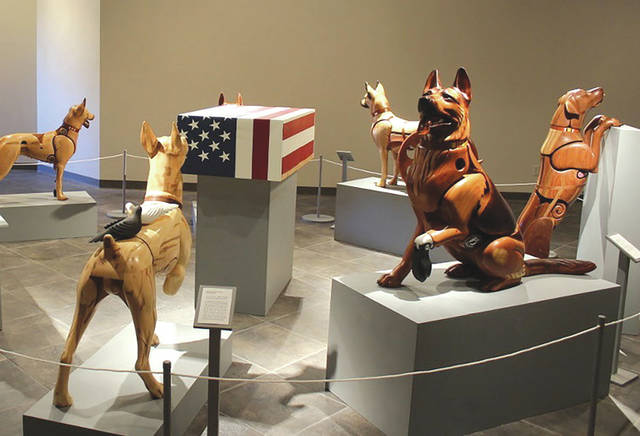
WRIGHT-PATTERSON AIR FORCE BASE — A new travelling exhibition of wooden dog sculptures featuring eight Wounded Warrior Dogs and four Canine War Dogs will be on display at the National Museum of the United States Air Force from Nov. 8, 2019, through Jan. 31, 2020.
The exhibit, titled “Canine Warriors – Courage and Sacrifice, Always Beside You,” was designed by Ohio master craftsman James Mellick to not only bring attention to the service and heroism of military working dogs, but to be symbolic of the courageous sacrifices and wounds suffered during battle by their human companions and to raise awareness about their needs.
Mellick, who first began carving from wood in 1976 while working as a teacher in New Hampshire, didn’t start creating dog sculptures until 1985. Although creating art was always important to Mellick, telling the story of military working dogs and their handlers was not at the forefront of his mind at first.
“Deer were getting into my garden and I got this idea to make these really rough dogs to be placed outdoors that I called ‘scare deers,’” said Mellick. “So I put a couple of these ‘dummy dogs’ out there in the field, and neighbors would say, ‘Hey, there were a couple of coyotes coming up and they saw those dogs and they turned around and went back.’ So it worked for a while, but you would have to keep moving the dogs around to make it look realistic.”
Later, Mellick saw news stories about soldiers coming home to the Veterans Administration with injuries that seemed a lot worse than those from Vietnam, and he received a new calling to help tell these stories.
“I was inspired and the idea came to me because I have always worked with dogs,” said Mellick, who began the creation of the “Wounded Warrior Dogs Project” after retiring from teaching in 2014, and started touring the exhibition in 2015.
As his sculptures grew in popularity, there was an explosion of interest and Mellick became involved with a whole military dog community that he didn’t even know existed.
“What I think is so poetic and so beautiful is this bond or melding that takes place between the handler and the dog of complete dependence, unconditional love and the will to survive in the most dire of situations amongst the two of them,” said Mellick. “And the narrative way that I work of storytelling was perfect for this group, so I had to tell the story of the dogs and their handlers.”
Mellick begins each project with a small sketch that he puts on his computer and enlarges. He then cuts the drawing into patterns that he traces on blocks of wood. He carves away the corners and starts shaping the sculpture, carving the heads, legs and tails separately before fastening them together at the end.
“The problem with wood is, it is so rigid,” said Mellick, who spends an average of 160 hours on each dog sculpture. “But at the same time, it is a little more monumental and spiritual than other materials.”
His first group of dogs were not designed to be about a specific dog, but rather a tribute for every military working dog, with the focus on the sacrifices that veterans make through their dogs. Over time though, his exhibits transitioned to telling real stories about the sacrifices the veterans and dogs have made.
Among the sculptures that visitors will see on display is the story of “Cooper” and “Lucca,” who were on assignment together in Iraq in 2007. Between patrols, the dogs snoozed together in shady patches or cavorted with a deflated football.
On July 6, 2007, Cooper and his handler, Army Cpl. Kory Wiens, were on patrol when an insurgent remotely detonated an IED hidden in a haystack killing both instantly. The dove that Mellick placed on Cooper’s sculpture signifies the angel wings he earned and the football is Cooper’s connection on Earth to Lucca, and celebrates the dogs’ playfulness and camaraderie, which brought joy to the warfighters.
Lucca, who was trained to detect explosives for the Marine Corps, completed more than 400 missions over a 6-year career. In 2012 while on patrol in Afghanistan, she barely survived an IED blast. In 2016, she received the prestigious Dickin Medal for “conspicuous gallantry” by the People’s Dispensary for Sick Animals, a British organization, which is depicted on her sculpture.
Although Mellick did not serve in the military, he views his sculptures, which tell stories of courage, honor, faithfulness and sacrifice, as his payback to those who have served and continue serving today.
Despite the long hours and sometimes grueling nature of the job, Mellick has no plans to slow down and is energized by the feedback he receives – especially those in the military working dog community.
“I’ve had young veterans put their arms around me weeping, crying and thanking me for doing this,” Mellick said. “So I’m running on that adrenaline of appreciation for what I’ve done and what artist doesn’t like that?”
Accompanying the exhibit will be art from the Air Force Art Program depicting military working dogs.


